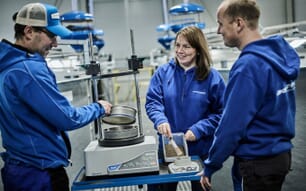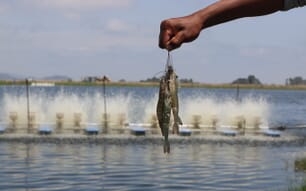Postdoctoral researcher Sally Molloy, a microbiologist in UMaine’s School of Marine Sciences, made the discovery last summer along with graduate student Michael Pietrak. Ian Bricknell, the Libra Professor of Aquaculture Biology and director of UMaine’s Aquaculture Research Institute, and Debbie Bouchard, manager of the Maine Aquatic Animal Health Laboratory at UMaine, provided research support.
“Extractive species are filter-feeding so they’re taking in all the phytoplankton and zooplankton and whatever’s in the water column, but they’re also taking in excess fish food and feces and removing all those organics from the water,” Ms Molloy said.
“The idea is hopefully IMTA practices reduce the amount of nutrients that are going into the ecosystem because of the fish farm. It’s sort of a greener version of farming. There are all kinds of other benefits because you’re diversifying your product.”
The research that went into the sea lice findings and other IMTA-related work is being funded by about $1.6 million in grants from organisations such as Maine Sea Grant, the Maine Technology Institute, Maine Technology Asset Fund, the US Department of Agriculture’s Northeast Regional Aquaculture Center, the National Oceanographic and Atmospheric Administration, and the Maine Aquaculture Innovation Center.
The sea louse, which feeds on the skin and tissue of its host, has a life cycle consisting of 10 stages. Most research to eradicate sea lice infestations has focused on the stages of the louse when it has already infected its host. Farmers of finfish such as salmon and trout had for the last 10 years used a drug called SLICE against the louse, but the parasite has shown resistance to the drug.
The UMaine research focuses on eradicating the sea louse in its larval stage.
To conduct the experiment, the researchers collected sea lice egg strings from an infected commercial salmon farm in Maine. The eggs hatched and were reared to the copepodid stage. Meanwhile, the team obtained mussels from a local commercial mussel farmer and placed the mussels in a system with artificial seawater.
The mussels were exposed to the sea lice copepods for either 30 or 60 minutes, after which time the contents of the mussels’ stomachs were removed and DNA analysis was performed. The analysis determined the mussels had ingested the sea lice copepodids.
The UMaine team will continue its research later this year, taking its work out of the laboratory and into the field. Although the date and exact location have not yet been determined, the researchers will insert a mussel raft into the waters of a salmon farm on the Maine coast to find out if their results from last summer hold up on a larger scale. The populations of mussels, salmon and sea lice will be monitored for several years to determine what effect they have on each other.
“In our preliminary experiments we exposed mussels to some number of sea lice and we could see they were capable of eating them,” Ms Molloy said. “But we need to get a better understanding of disease dynamics on a farm.”
The farm, with its combination of species, will be the first of its kind in Maine.
Should the mussel raft prove effective against sea lice infestations in salmon farms, the IMTA technique could be used on a wider scale in combination with other methods, including drugs known as chemotherapeutics.
“Historically sea lice is probably the greatest economic pathogen that has affected the salmon farming industry worldwide, over the history of salmon farming,” Mr Pietrak said.
“One of the things we have always strived for in the state of Maine with our sea lice management is the use of integrated pest management. So while we don’t say no to chemotherapeutics, we try to minimise their use. IMTA represents a possible new management strategy.”
Salmon has for at least the past 10 years been the third-most consumed seafood behind shrimp and canned tuna, according to statistics from the National Marine Fisheries Service.
The findings were published in the journal Aquaculture and have implications for the farmed salmon industry in Maine. If further analysis in the field holds up, the use of mussels on salmon farms could be another disease management strategy for reducing the infectious pressure of sea lice in a finfish farm.
The paper also has implications for the development in Maine of a concept called integrated multi-trophic aquaculture (IMTA), an alternative approach to the standard mono-culture aquaculture. IMTA is believed to reduce the environmental impacts of commercial aquaculture systems by combining the cultivation of fed species, such as salmon, with extractive species, such as mussels.
Researchers Make Discovery On Sea Lice Infestations
US - University of Maine researchers have published a paper in which they demonstrate that blue mussel can eat the larvae of sea louse, a parasitic pest that has recently made a comeback on fish farms, decimating populations of farmed finfish.





